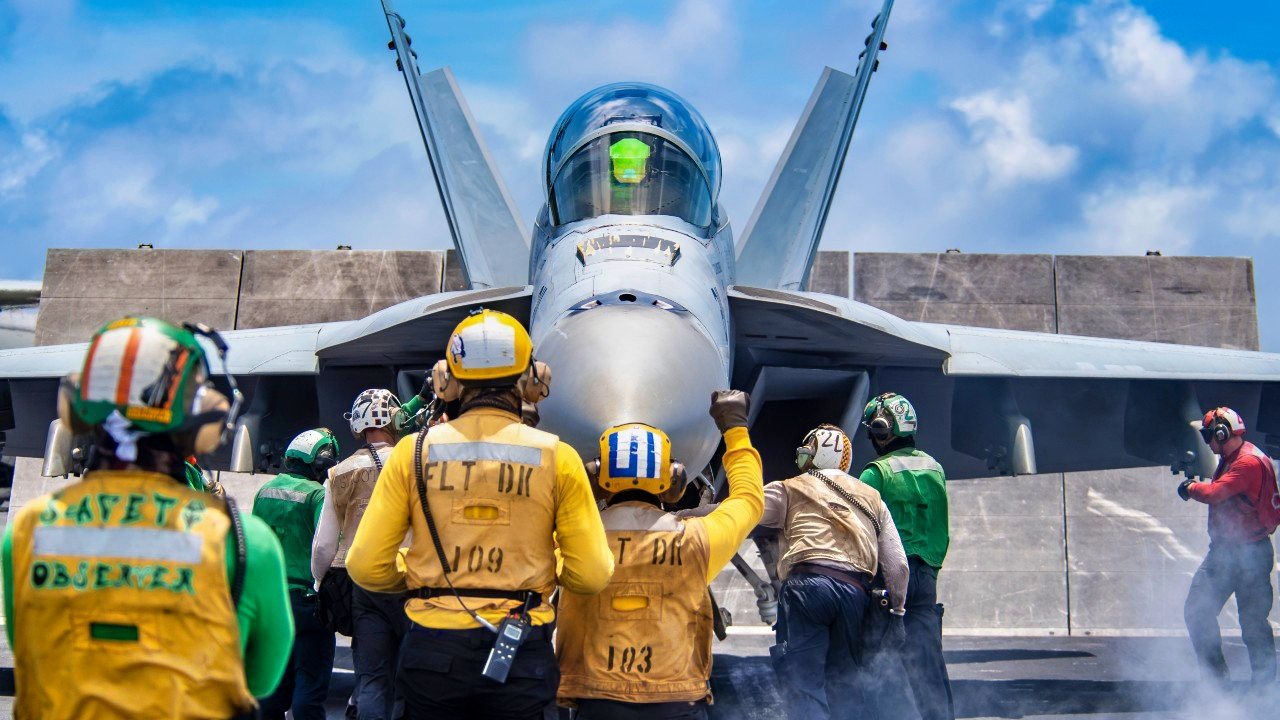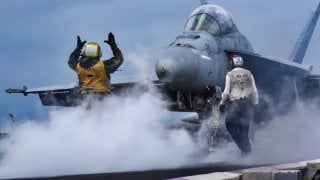The Navy's Aircraft Carrier Nightmare Is Just Getting Started
Advances in technology have made aircraft carriers vulnerable to enemy fire once again. Anti-ship missiles can now reach and challenge the air defense of an aircraft carrier group. This development could change the face of war in a potential conflict between the U.S. and China in the Indo-Pacific.
Picture the following: China invades Taiwan, catching the United States and the world by surprise. The U.S. abandons its long-standing ambiguity around Taiwan and commits military force to prevent Taipei from falling into China’s hands. The U.S. Navy answers the call and steams in force toward the area of operations.
Aircraft carrier battle groups make up the core of America’s response. But as they approach the battlespace and before they get into range to launch their fighter jets, the Chinese military launches hundreds of ballistic and cruise missiles against the American warships.
What happens next? Is the age of the aircraft carrier over?
Aircraft Carriers vs. Missiles: Who Wins?
Advances in technology have made aircraft carriers vulnerable to enemy fire once again. Anti-ship missiles can now reach and challenge the air defense of an aircraft carrier group. This development could change the face of war in a potential conflict between the U.S. and China in the Indo-Pacific.
Understanding the limitations on naval power—limitations that have more to do with quality rather than quantity since the Chinese Navy is the largest in the world—Beijing has been investing heavily in Anti-Access/Aerial-Denial (A2/AD) systems that would create a large kill-zone in the event of a near-peer conflict.
Using mainly anti-ship missiles, including hypersonic munitions that travel at extreme speeds and are hard to intercept, the Chinese military threatens to sink any U.S. warship that approaches the denied area.
For example, if Beijing decides to invade Taiwan and force a reunification by arms, it would use this A2/AD bubble around the island nation to prevent any U.S. or other assistance from reaching Taipei.
So, the mightily expensive U.S. aircraft carrier fleet wouldn’t be able to do anything, at least in theory. (Chinese A2/AD systems, such as the DF-26 ballistic missile with a range of 2,000 miles or more, are designed to include the combat radius of carrier-based fighter jets to ensure that an aircraft carrier can’t stay out of the kill zone but still be able to launch its aircraft.)
This is a credible threat, and the Navy has been working on countering it. New air defense technology, including rolling air defense missiles and directed energy (laser) weapons, is being tested. However, in a potential conflict, the Chinese military would likely launch hundreds of missiles against the carrier fleet. So, even the most advanced air defense systems would face a hard time intercepting a rain of missiles. And it would only take a couple of missiles to render an aircraft carrier combat ineffective.
What Will the Aircraft Carrier Do Now?
The answer to this strategic conundrum might lie in combined operations.
The Chinese A2/AD systems might be powerful, but what is more powerful is the U.S. Air Force and the U.S. military’s long-range capabilities.
In the event of a conflict, the Chinese A2/AD systems would be a high-value target and a top priority for strikes. Special operations forces and cyber operations can also play a role in countering Chinese long-range systems and ensure that they don’t operate as intended when the time comes.
Most importantly, however, the U.S. Navy should accept the level of risk associated with having nuclear-powered aircraft carriers at the crosshairs of China’s A2/AD systems and learn to live with it.
Each aircraft carrier costs billions of dollars, and a loss would be a hit. But it wouldn’t—and shouldn’t cripple—the Navy.
The U.S. Aircraft Carrier Fleet
The Navy has 11 aircraft carriers and several smaller warships that can double as light carriers if necessary. As far as the main carriers, the Navy fields 10 Nimitz class and one Ford-class warship.
The USS Gerald R. Ford (CVN-78) is the first of its class and the most advanced aircraft carrier in the world with the ability to launch and recover aircraft at much faster rates, while also requiring a smaller crew to operate. The Navy is awaiting several ships of the class to join its fleet in the next few years.

In the Nimitz-class, the Navy has the USS Nimitz (CVN-68), USS Dwight D. Eisenhower (CVN-69), USS Carl Vinson (CVN-70), USS Theodore Roosevelt (CVN-71), USS Abraham Lincoln (CVN-72), USS George Washington (CVN-73), USS John C. Stennis (CVN-74), USS Harry S. Truman (CVN-75), USS Ronald Reagan (CVN-76), and USS George H. W. Bush (CVN-77).
All of the Navy’s aircraft carriers are powered by nuclear energy and can stay on station for as long as their provisions allow.
And yet, not all 11 aircraft carriers are operationally ready at all times. The Navy is using a rotational system that allows ample time for ships to receive maintenance and refitting and the crews training and rest in between their deployments. Through this system, approximately six carriers are available at a moment's notice. In the event of a near-peer conflict, the rotational system would likely go out of the window, and all 11 warships would be ready for war.
About the Author
Stavros Atlamazoglou is a seasoned defense and national security journalist specializing in special operations. A Hellenic Army veteran (national service with the 575th Marine Battalion and Army HQ), he holds a BA from the Johns Hopkins University, an MA from the Johns Hopkins’ School of Advanced International Studies (SAIS). He is pursuing a J.D. at Boston College Law School. His work has been featured in Business Insider, Sandboxx, and SOFREP.


